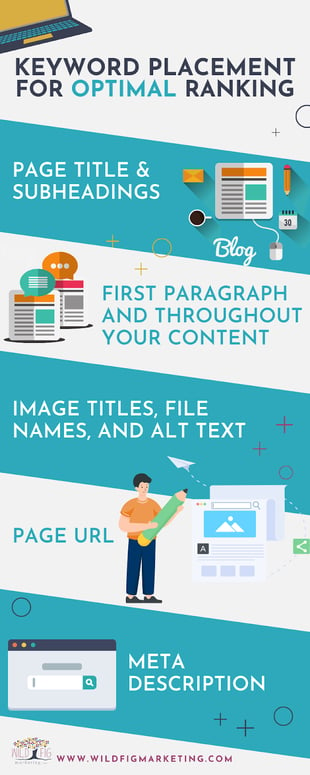How To Build a Content Creation Framework (and Why You Need One)
Creating content for your blog, website, lead magnets, and so on takes a lot of time and effort. If you don’t plan ahead and keep it all organized,...
6 min read
 Jamie Beebe
:
April 5, 2023
Jamie Beebe
:
April 5, 2023
![How To Optimize Your Content for SEO [the Answer May Not Be What You Think]](https://www.wildfigmarketing.com/hubfs/bigstock-Seo-Concept-Search-Engine-Opt-468613473.jpg)
You have a great piece of content on your website, but it doesn’t seem to be getting much traffic. In fact, you’re pretty sure the only people who’ve read it are your work colleagues, that one person who reads everything you post (thanks, friend!), and maybe your mom.

While the support of your mom and Marge from Accounting is great, that’s not really why you shared the piece on your site. You hoped to educate website visitors and attract new leads.
So how do you get your content seen by the masses?
The answer is SEO.
Ok, I’m pretty sure I just heard you sigh. I know I know…talking about SEO is about as exciting as getting your teeth cleaned.
But, like dental checkups, oil changes, and walking the dog, SEO is a necessary and important task that needs to be taken care of so the real magic can happen.
Much like getting your oil changed keeps your car from exploding and walking the dog keeps Fido from using your living room carpet as a bathroom, good SEO keeps your content from being relegated to the dark recesses of the internet, never to be seen again.
SEO, or Search Engine Optimization, is the art of optimizing your blogs and other website content to improve your rankings in searches on Google and other search engines. And while its name may conjure images of tech bros typing line after line of green code on a black screen, SEO isn’t as complicated as it sounds.
So, come on (*grabs you by the arm and tugs gently*), let’s take a look at how to optimize your content for SEO. (I promise it’ll be painless.)
Creating content with good SEO typically involves a list of tactics like using targeted keywords, getting backlinks from other reputable sites, and so on. And while these things aren’t the only aspects of SEO to consider, we really can’t talk about SEO without talking about them.
So here are a handful of basic SEO tactics that can help bring in traffic to your website:
 Use keyword research to inform your content strategy. Research popular keywords for your industry, and choose ones that are relevant to your business. Use the keywords you find to determine the topics you’ll write about.
Use keyword research to inform your content strategy. Research popular keywords for your industry, and choose ones that are relevant to your business. Use the keywords you find to determine the topics you’ll write about.Want to learn more about these SEO strategies? Check out this blog we wrote on improving blog SEO.
While these things certainly help with SEO, there’s so much more to optimizing your content than keywords and backlinks. In fact, writing great content is far more important than any of these tactics.
The best way to improve your search engine rankings is to consistently post relevant, readable, engaging content on your website. But what exactly does that involve?
 Make sure the content you’re writing is something your target audience can relate to and would want to read. For instance, blogs addressing your customers’ frequently asked questions, business or industry updates, or deep dives on products, services, or industry concepts might be interesting to your readers.
Make sure the content you’re writing is something your target audience can relate to and would want to read. For instance, blogs addressing your customers’ frequently asked questions, business or industry updates, or deep dives on products, services, or industry concepts might be interesting to your readers.
Also, make sure the topics you pick have some traffic potential (a.k.a., people are already looking for it). This is where keyword research comes in handy: it helps you find topics in your industry that are already getting good traffic. From there, choose topics that relate specifically to your audience.
In other words, don’t write clickbait (content that appears to be about one topic, but is focused entirely on something else). Here’s an example: if you’re writing a blog with the keyword “how to optimize your content for SEO,” (😉) make sure it actually covers that topic.
And definitely don’t use a headline as clickbait to get people to your page, only to try to sell them something. It will backfire and your bounce rate will go through the roof.
.gif?width=325&height=325&name=giphy%20(1).gif)
You should also consider the buyer’s journey as you create content. While some users will be searching for products or services to use right away, others may not be quite ready to buy yet. So it’s a good idea to have a mix of content on your site that reflects the different stages of the buyer journey.
Make sure your content covers the topic at hand thoroughly. Be as comprehensive as possible to ensure you’re answering your readers’ questions and effectively displaying your knowledge on the topic.
Google’s search quality standards give preference to content that displays the E.E.A.T. principle (or Experience, Expertise, Authoritativeness, and Trustworthiness):
.gif?width=321&height=321&name=giphy%20(2).gif) Generally speaking, the longer your blogs are, the better your SEO will be. It’s easier for longer content to rank higher in search results. According to HubSpot research, 2,100-2,400 words is ideal for blog SEO.
Generally speaking, the longer your blogs are, the better your SEO will be. It’s easier for longer content to rank higher in search results. According to HubSpot research, 2,100-2,400 words is ideal for blog SEO.
However, that’s not the case if most of your copy is filler. Not every topic lends itself to 2,000+ words. It’s more important to focus on answering your reader’s questions than to try to hit a certain word count. (However, blogs that are too short have little to no hope of showing up in searches, so try to keep your word count above 300 words.)
The content of your blogs and website copy should be concise, engaging, and well-researched. A few tips:
Finally, creating content for better engagement means writing content that is highly readable.
Even though we’re talking about search engine optimization, it’s important not to lose touch with the fact that you’re ultimately writing for people, not search engines. In short, write for your audience’s sake, not for Google’s sake.
First of all, keep your tone conversational. You’re not giving a presentation, you’re telling a story or having a chat about an interesting topic. Talk with your readers the way you would at a networking event or cocktail party, not during a business meeting.
Also, don’t assume every website visitor will read every word on the page. The reality is, most people skim. They’re looking for a quick answer to their question. Writing readable content means making sure it’s not only easy to read and understand but also easy to skim.
Use headlines, bulleted lists, callouts, and bolded text to highlight the bits of information your readers will especially be looking for. Work to use short, simple words and shorter sentences, and don’t overuse jargon, adjectives, and adverbs. In other words, keep your writing simple and concise.
Note: Just because people aren’t reading every word doesn’t mean that grammar and punctuation don’t matter! Correct use of vocabulary, grammar, and punctuation makes your content more readable.
In addition to making your content more accessible to your readers, readability also makes it easier for Google and other search engines to crawl and index your content…it’s a win-win.
If you’ve read (or skimmed 😉) this far, and it feels like learning how to optimize your content for SEO is too much for you, we get it. It’s a lot! Luckily, there are people out there who do this for a living. And by that, I mean Content Writers.
Content writers LIVE for writing your blogs for you. Really, they love it: they’re the nerds who agonize over comma placement and actually enjoyed writing papers in school! Writing blogs and other copy for your website is like Disneyland to them (ok maybe not quite Disneyland…but close!). And we have two great writers on the Wild Fig team who would love to write for you!
If you’d like to explore having a professional content writer create content for your website, schedule a quick exploratory call to learn more!


Creating content for your blog, website, lead magnets, and so on takes a lot of time and effort. If you don’t plan ahead and keep it all organized,...

Content marketing is one of the most effective ways to promote products and services. But for many business owners, the stress of having to create...
![Pros and Cons of Using AI To Write Content [+ 5 Ways To Use It Effectively]](https://www.wildfigmarketing.com/hubfs/bigstock-System-Artificial-Intelligence-468896699.jpg)
Before you outsource all your content to ChatGPT, consider the pros and cons of using AI to generate digital content.